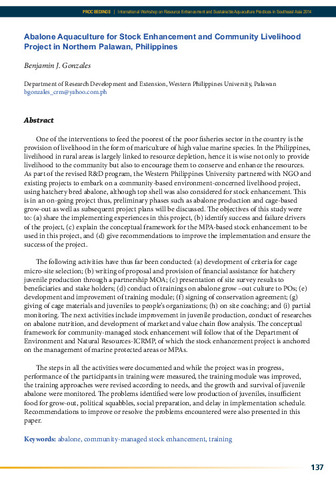| dc.contributor.author | Maliao, Ronald | |
| dc.contributor.author | Webb, Edward | |
| dc.contributor.author | Jensen, Kathe R. | |
| dc.coverage.spatial | Philippines | en |
| dc.date.accessioned | 2023-09-05T06:36:42Z | |
| dc.date.available | 2023-09-05T06:36:42Z | |
| dc.date.issued | 2004 | |
| dc.identifier.citation | Maliao, R. J., Webb, E. L., & Jensen, K. R. (2004). A survey of stock of the donkey’s ear abalone, Haliotis asinina L. in the Sagay Marine Reserve, Philippines: Evaluating the effectiveness of marine protected area enforcement. Fisheries Research, 66(2–3), 343–353. https://doi.org/10.1016/S0165-7836(03)00181-4 | en |
| dc.identifier.issn | 0165-7836 | |
| dc.identifier.uri | http://hdl.handle.net/10862/6480 | |
| dc.description.abstract | Marine protected areas (MPA) are tools for integrated coastal management (ICM); they have gained worldwide acceptance as a strategy for resource restoration and conservation. Research must gauge the effectiveness of MPA implementation in promoting fisheries recovery. This study investigated the effectiveness of enforcement in the Sagay Marine Reserve (SMR), western Philippines, in promoting the recovery of abalone stock. Enforcement of protection in the SMR is accomplished through the bantay-dagat (sea patrol), which utilizes reef watchtowers to deter illegal activities. The abalone populations in two protected reefs (well-enforced protection) and two open access reefs (poorly enforced protection) in the SMR were surveyed using 50m x 2m belt transects. Abalone density was significantly greater, and abalone were larger, on protected than on unprotected reefs. However, we found that recruitment appeared limited at all sites, and that abalone tended to be sexually mature at small sizes. This may indicate that the population has been near a critical threshold, that recent climatic events may have suppressed recovery rates, and/or that enforcement and rule compliance was low and with continued poaching. Nevertheless, the results of this study agree with findings of other research that a properly enforced no-take MPA can promote recovery of local stocks. Moreover, the investment of funds by the local government in monitoring activities (in this case, watchtowers) is necessary to achieve MPA objectives. | en |
| dc.description.sponsorship | The authors were supported by a scholarship and grant from the Danish International Development Assistance (DANIDA), administered through the Integrated Tropical Coastal Zone Management inter-disciplinary program at the Asian Institute of Technology. The Southeast Asian Fisheries Development Center-Aquaculture Department (SEAFDEC-AQD), based in Iloilo, Philippines co-funded this study under study code SE-03-M2002T. | en |
| dc.language.iso | en | en |
| dc.publisher | Elsevier | en |
| dc.subject | abalones | en |
| dc.subject | Haliotis asinina | en |
| dc.title | A survey of stock of the donkey’s ear abalone, Haliotis asinina L. in the Sagay Marine Reserve, Philippines: Evaluating the effectiveness of marine protected area enforcement | en |
| dc.type | Article | en |
| dc.citation.volume | 66 | en |
| dc.citation.issue | 2-3 | en |
| dc.citation.spage | 343 | en |
| dc.citation.epage | 353 | en |
| dc.citation.journalTitle | Fisheries Research | en |
| dc.subject.asfa | marine molluscs | en |
| dc.subject.asfa | coral reefs | en |
| dc.subject.asfa | recruitment (fisheries) | en |
| dc.subject.asfa | stock assessment | en |
| dc.subject.asfa | nature conservation | en |
| dc.subject.asfa | enforcement | en |
| dc.subject.asfa | marine parks | en |
| dc.subject.asfa | population structure | en |
| dc.subject.asfa | environmental protection | en |
| dc.identifier.essn | 1872-6763 | |
| dc.identifier.doi | 10.1016/S0165-7836(03)00181-4 | |
| dc.subject.scientificName | Haliotis asinina | en |
| local.subject | Abalone | en |
| local.subject | Integrated coastal management | en |
| local.subject | Haliotis asinina | en |
| local.subject | Marine protected area | en |
| local.subject | Mollusks | en |
| local.subject | Monitoring | en |
| local.subject | Reef conservation | en |



